| A Big Data Bestseller! | |

|
Designing Data-Intensive Applications |
<< Back to Part 2 of my Java MVC Example
MVC: Handling data-changing events
Whenever the user adds, edits, or deletes data, such as our Process data, all the proper GUI components need to be notified of this event so they can properly update their displays. In this application, when a user adds a new Process, this means that we need to update our MainProcessTable. We implement this as follows:
- The user presses the OK button on the
EditProcessDialog. - This triggers an okButton actionPerformed event. This event is caught by the
ProcessController(or perhaps by a smallerAddProcessController). - The controller validates the user data.
- If there is a problem with the data, the
EditProcessDialogremains shown, with an error message indicating the problem. - Otherwise, if the the data is okay, the controller inserts the new
Processinto the database using aProcessDaoobject, with a method call that looks like this:processDao.insert(process); - If the database insert is successful, the controller also add the new
Processto our internal list of Process objects, like this:processes.add(process); - Because the JTable's
TableModelalready has a reference to myprocessesobject, it already has the new data, and the last thing I need to do is to tell theTableModelto fire itsfireTableDataChangedevent. Firing this event tells the listeners of this event that theTableModeldata has changed, and you're going to want to repaint yourself. In this example, this specifically means that theMainProcessTablewill repaint itself, correctly showing the new data. If other GUI components have registered themselves as listeners of theMainProcessTableModel, they will also be updated.
Summary of my Model View Controller (MVC) Java example
I hope this has served as a good example of how to use the Model View Controller (MVC) pattern in a real-world software application. If you'd like me to add any more detail to this article, or you have any other questions or comments, just use the comment form below.
<< Back to Part 2 of my Java MVC Example
Related Model View Controller (MVC) content
Before I leave, here are links to some of my other Model View Controller (MVC) content:



